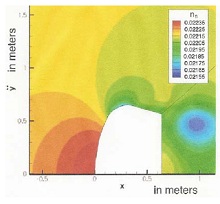Ressources
Livres Blancs
- Bridging the Terahertz Gap
- Modeling the Lithium-Ion Battery
- Protection contre la Corrosion
- Modélisation des batteries
- Modélisation et Simulation dans le développement des piles à combustible
- Modélisation thermique des petits satellites
- Analyse électro-vibroacoustique d'un transducteur à armature équilibrée
Electrostatic Fluid Structure Interaction (EFSI) on the Huygens Experiment
Publié en 2010
The Huygens Atmospheric Structure Instrument (HASI) was designed to characterize the physical properties of the lower atmosphere and surface of Titan, the planet-size moon of Saturn. The Relaxation Probe (RP) sensor on the Huygens probe, determined the electrical conductivity in the lower atmosphere of Titan, from 140 km to 40 km. It was suspected that at an altitude above 100km, the booms were not fully deployed, and a contamination of measurements was likely to occur. In this present work, we numerically study a geometrical effect, which is linked to the electrostatic fluid structure interaction (EFSI) between the vessel and the RP. The mathematical model of the electrostatic interaction between the vessel and the RP consists in solving linear elliptic partial differential equations with finite element methods, for a complex geometry, with boundary conditions for the electric potential and the electron number density. We were able to obtain lower and upper bounds for the interaction.

Téléchargement
- godard_presentation.pdf - 1.12MB
- godard_paper.pdf - 0.26MB
